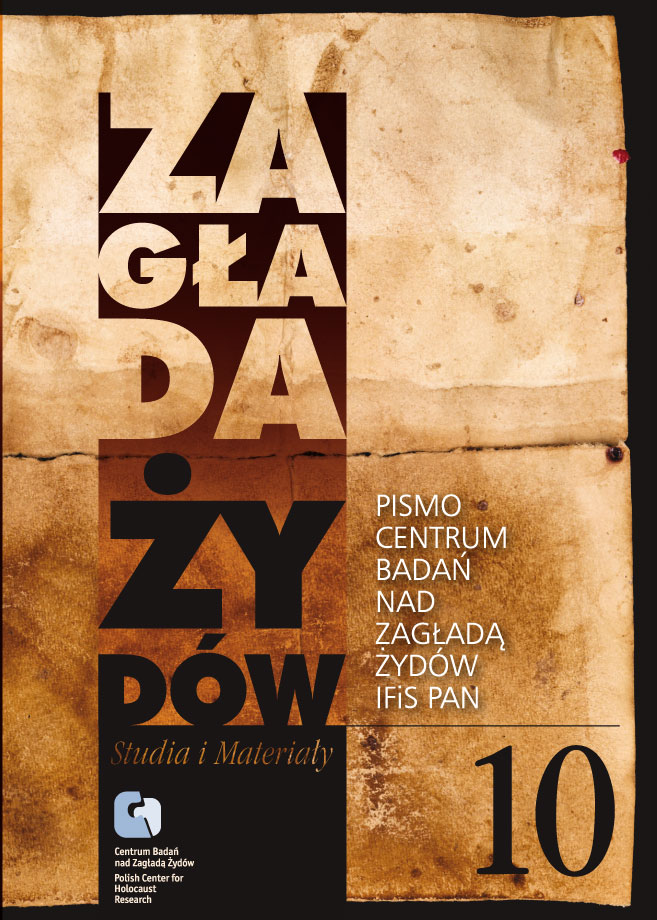Józef Kermisz (1907–2005) – twórca badań nad Szoa
Zagłada Żydów. Studia i Materiały, Nr 10 (2014), Strony: 304-316
Data zgłoszenia: 2020-10-22Data publikacji: 2014-12-01
 https://doi.org/10.32927/ZZSiM.526
https://doi.org/10.32927/ZZSiM.526
Abstrakt
Józef Kermisz (1907–2005) was a historian and an archivist who helped lay the foundations for Shoah research in Poland and Israel. In 1944 joined the Central Jewish Historical Commission where became the chief archivist. Since then his life has been devoted to retrieving wartime archival material. As archive director (in the Jewish Historical Institute in Poland and at Yad Vashem in Israel) he sought to develop an archive both for future historical research and for trials of suspected war criminal. He played a major role in discovering and preserving important documentation on the Shoah in Poland. Among his major professional achievements were preparing documentation for the prosecution in the Eichmann trial, and publishing Czerniakow’s diary and the full edition of the underground press of the Warsaw ghetto. He was one of the world’s leading experts on the Ringelblum Archive and other hidden Jewish documentation from the Holocaust. Kermisz left behind a legacy of a vast research infrastructure that he created and that will occupy scholars for generations.
Licencja
Prawa autorskie (c) 2014 Autor & "Zagłada Żydów. Studia i Materiały"

Utwór dostępny jest na licencji Creative Commons Uznanie autorstwa 4.0 Międzynarodowe.
https://creativecommons.org/licenses/by/4.0
Inne teksty tego samego autora
- Avner Shalev, Dan Michman, David Silberklang, Ścisła pamięć o Zagładzie w Muzeum Historii Holokaustu w Yad Vashem. Odpowiedź na artykuł Amosa Goldberga , Zagłada Żydów. Studia i Materiały: Nr 7 (2011)
Podobne artykuły
- Krzysztof Czubaszek, Stanisław Żemis – świadek zagłady Żydów w Łukowie , Zagłada Żydów. Studia i Materiały: Nr 14 (2018)
- Jacek Leociak, Zagłada w „Muzeum życia” (Muzeum Polin i jego kłopoty z muranowskim genius loci) , Zagłada Żydów. Studia i Materiały: Nr 11 (2015)
- Joanna Gubała-Czyżewska, Upamiętnienia Łodzi żydowskiej – w jaki sposób przeszłość uobecnia się w teraźniejszości , Zagłada Żydów. Studia i Materiały: Nr 16 (2020)
- Bartłomiej Krupa, Critical History and its ‘Shadow Cabinet’. Polish Historiography and the Holocaust during 2003–2013 , Zagłada Żydów. Studia i Materiały: Nr Holocaust Studies and Materials (2017)
- Andrzej Grzegorczyk, Procedura i przebieg transportów kolejowych z getta łódzkiego do obozu zagłady w Chełmnie nad Nerem (styczeń–maj 1942 r.) , Zagłada Żydów. Studia i Materiały: Nr 16 (2020)
- Redakcja, Od Redakcji , Zagłada Żydów. Studia i Materiały: Nr 11 (2015)
- Piotr Rypson, Album rysunków Teofili Langnas-Reich w Archiwum Ringelbluma , Zagłada Żydów. Studia i Materiały: Nr 18 (2022)
- Marta Janczewska, O śmierci w niemieckim języku oficjalnym na przykładzie raportu Jürgena Stroopa , Zagłada Żydów. Studia i Materiały: Nr 12 (2016)
- Krzysztof Persak, Ekshumacja, której (prawie) nie było. Prace archeologiczno-ekshumacyjne w Jedwabnem w 2001 r. i ich wyniki , Zagłada Żydów. Studia i Materiały: Nr 14 (2018)
- Marta Tomczok, „Polecieć tam, gdzie nie ma getta, szopu…” Dziennik Rutki Laskier między nekroestetyką a nekropolityką , Zagłada Żydów. Studia i Materiały: Nr 14 (2018)
<< < 1 2 3 4 5 6 7 8 9 10 11 12 13 14 15 16 17 18 19 20 21 22 23 24 25 26 27 28 29 30 31 32 33 34 35 36 37 38 39 40 41 42 43 44 45 46 47 48 49 50 > >>
Możesz również Rozpocznij zaawansowane wyszukiwanie podobieństw dla tego artykułu.
 English
English
 Język Polski
Język Polski








